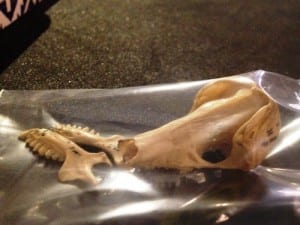The Mystery of the Giant Golden Mole Skull
By zcbtekp, on 16 February 2016
Crawling blindly through tunnels under layers of dead leaves in the coastal forests of South Africa lives the giant golden mole. Most people don’t know it is there, and neither did I until I was presented with the skull of one this October. As this species lives exclusively in a tiny region on the Eastern Cape – most people have definitely never seen one! Who would have guessed that identifying this skull would be the start of my newfound love for these unlikely animals.
What’s in a label?
As part of the Vertebrate Life and Evolution module at UCL, students are asked to identify a “mystery vertebrate” specimen. I was given an unlabelled tiny skull and some jawbones, and they became an obsession for a few months. I’d taken measurements and photos from every angle, counted all of its teeth, drawn pictures of the weird plates of bone extending around the sides of its head.
The skull is conical in shape whilst the teeth look like those of an insectivore – maybe a mole? But one look at the skulls of some moles from the Grant Museum stores soon told me I was wrong, they looked completely different. I was led astray by the marsupial mole, which I’m told is “virtually indistinguishable” from the African golden moles. Their resemblance is nothing to do with them being related, so I was heading off track.
Things got more confusing when I found a specimen on display at the museum – a complete skeleton labelled “Cape golden mole”. I asked to see it up close, took (even more) measurements and photos, and was baffled at the idea it could be a Cape golden mole – all my reading told me this species was supposed to be much smaller than what I was seeing. Eventually, I realised its label was simply old (although very interesting from a historical perspective). A Latin name that didn’t even exist anymore should have been my clue that something was up: I had been looking at a complete giant golden mole skeleton all this time, with a skull almost identical to my mystery vertebrate!
My, what big inner ear bones you have
Within weeks I had gone from not even knowing it existed to being the giant golden mole’s biggest fan. My friends were sick of hearing about the mole, whilst I was still working out how it could be ‘giant’ from the 4cm skull I was given (it’s much larger than the other golden moles, which are really tiny). When I started to read more about it, I found out how truly weird and amazing this species is.
Giant golden moles are very reliant on their hearing, as they don’t have any eyes at all. As a result they have remarkably gigantic inner ear bones – the hammer and anvil bones are the biggest of any mammal, relative to their body size. This combined with the plates of bone extending around its head help the giant golden mole hear the sounds of worms and insects moving through the dirt.
In fact, its entire ear is geared towards detecting vibrations through the soil, rather than the air. These creatures have been observed rustling around in leaves at night by some researchers – if they weren’t quiet enough the animals were very quick to locate their tunnels again and hide. Quite an impressive feat for a completely blind species!
Some other crazy facts about golden moles include that they don’t bother regulating their body temperature like other mammals. You (assuming you are human) keep things at a comfortable 37°C at all times. If you were a golden mole things would be more changeable, and you’d need to eat a lot less – no need to waste all that energy maintaining your temperature. As well as this, they have really efficient kidneys and never need to drink water, so are pretty good at saving energy all round.
What can you do for the golden moles?
Now for the sad part – these animals are endangered. They are losing their coastal forest habitats, and are so highly specialised that they don’t have anywhere else to go. Some scientists predict they’ll be extinct within the next 30 years because of climate change. So recycle, turn down your thermostat, and get yourself some energy-saving lightbulbs – the giant golden mole needs you!
Elizabeth Pursey is a UCL student studying for an MSci in Biological Sciences
The golden mole skull is on display in the Museum until the end of term.
One Response to “The Mystery of the Giant Golden Mole Skull”
- 1
 Close
Close




[…] This course has been running for a few years, but this year we also experimented with the idea of how to communicate this type of research to a public audience – each student gave a 10 minute presentation in Museum during public opening hours. Despite a lot of nerves the students did a great job and it went so well we asked the students to write up museum labels discussing their objects for inclusion in a display; these labels are now on display in the Grant Museum (until Easter) so please drop by and visit! You can read one of the students’ takes on the process, and how she identified a giant golden mole on this blog post. […]